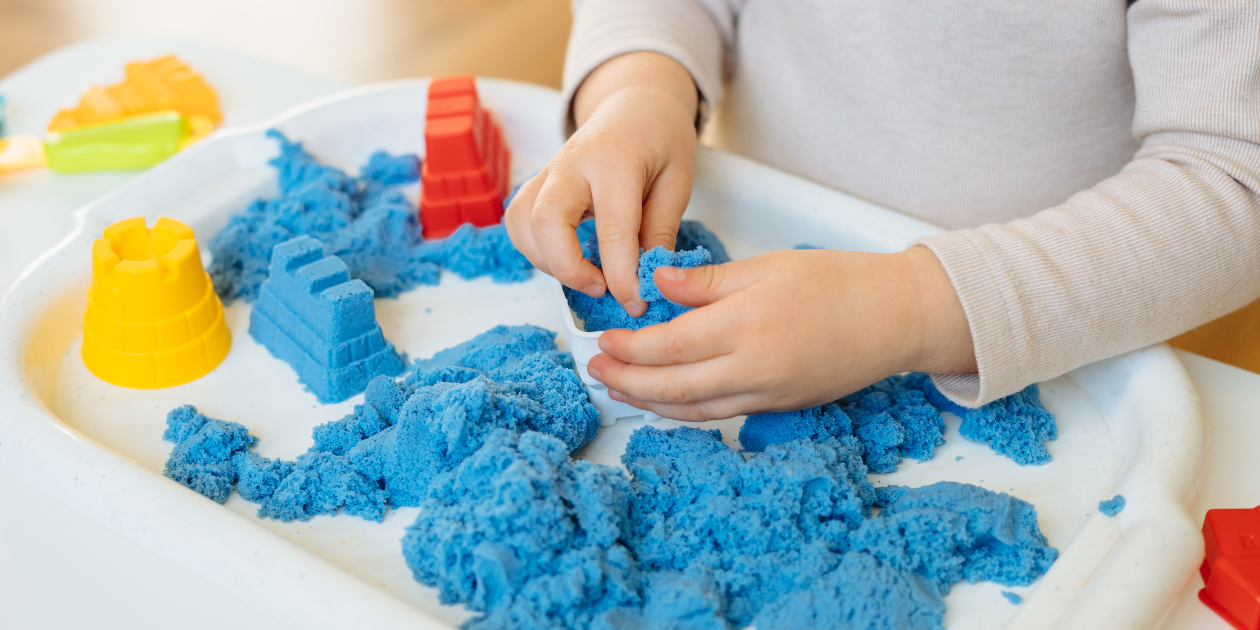
Children with autism often experience sensory sensitivities impacting their daily lives and development. Sensory play, characterized by engaging activities stimulating the senses, holds immense significance in supporting a child’s growth.
In this blog post, we’ll delve into why sensory play is crucial for children with autism, backed by research and expert insights, and how Circle City ABA incorporates it into our ABA therapy.
Understanding Sensory Play
Sensory play involves activities stimulating one or more senses: sight, sound, touch, taste, and smell. Sensory play in ABA therapy includes playing with textured materials, exploring different scents, listening to soothing sounds, or engaging in hands-on creative projects. For children with autism, sensory activities can be particularly beneficial due to their unique sensory processing challenges.
Sensory Sensitivities in Autism – A Brief History
Sensory play in Applied Behavior Analysis (ABA) therapy was first introduced in the late 1970s as a treatment for children who have difficulties with sensory processing. This practice was a response to the discoveries of Dr. A. Jean Ayres, who proposed in the 1950s and 1960s that difficulty processing sensory information could be directly related to difficulties found in everyday life. Sensory play in ABA therapy has since been adapted to meet the needs of children today.
Many children with autism have sensory sensitivities, meaning they can be either hypo-sensitive (under-responsive) or hyper-sensitive (over-responsive) to sensory stimuli. This can lead to behaviors like avoiding certain textures, covering ears in response to sounds, or struggling with transitions due to sensory overload. At Circle City ABA, sensory play provides a controlled environment for them to explore and interact with different sensory experiences at their own pace.
Sensory play in ABA therapy is significant due to its potential to enhance the effectiveness of interventions and support the overall development of children with autism. ABA therapy is a structured and evidence-based approach that focuses on teaching and reinforcing desired behaviors while reducing challenging ones. Integrating play into ABA therapy can offer numerous key benefits, as outlined below.
Why Sensory Play and Exploration Matters
- Development of sensory integration skills – Sensory play exposes children to various textures, sounds, and sensations, helping them learn how to process and integrate sensory information more effectively.
- Language and communication development– Sensory play can encourage verbal and nonverbal communication. It allows children to express their preferences, likes, and dislikes.
- Emotional regulation – Sensory play allows children to self-regulate their emotions and manage stress. It can have a calming effect and help reduce anxiety.
- Motor skills development – Playing with sand, finger painting, or manipulating objects can enhance fine motor skills and hand-eye coordination.
- Social interaction – Group sensory play sessions can foster social interactions, turn-taking, and cooperation among children, promoting positive peer relationships.
- Cognitive growth – Exploring sensory experiences stimulates cognitive development by encouraging exploration, problem-solving, and creativity.
Sensory play isn’t just about having fun; it’s a powerful tool for promoting the development and well-being of children with autism. Providing a safe and controlled way to engage with sensory experiences empowers the children we serve to navigate the world more confidently and easily.
4 Examples of Sensory Activities for Kids with Autism
Since the creation of sensory play, as well as the integration of sensory play in ABA therapy, there have been numerous activities developed to accommodate children with autism. Some of these activities and their benefits include the following.
1. Finger or Foot Painting
This is the perfect sensory play activity for children to express themselves without having to use words. All you have to do is set up a painting station and materials for the child, come up with a topic for them to paint, and let their imagination run wild! Also, during this activity, the child can either paint with their hands or feet depending on their preference.
2. Scented Play-Doh Activities
Taking Play-Doh and adding different scented oil extracts to it allows children to activate their sense of smell and identify various aromas. Though these scents may smell delicious, make sure the child does not eat the Play-Doh during this activity!
Along with exercising your child’s sense of smell, you can also encourage them to construct different shapes using the Play-Doh provided. This can help further increase their motor skills, as well as their sense of creativity during designated sensory playtime.
3. Sensory Walks or Bins
Sensory walks can help aid your child’s balance and coordination. This activity involves letting your child walk or crawl across various mats or rugs so they can take in all the different textures they feel as they navigate their way across.
For a twist on this activity, sensory bins are also one of the best sensory activities for kids with autism. For this activity, we recommend filling a bucket with different textured materials, such as rice or sand, and hiding toys for your child to find. Once completed, this sensory play activity can provide hours of fun as children further improve their hand-eye coordination and motor skills.
4. Pouring Station
This sensory play activity is another great way for children to practice their hand-eye coordination. For the best experience possible, our team recommends placing a container that can be filled with water on the floor. From there, gather other containers that vary in both size and shape. The types of containers you choose can include the following:
- Water pitchers
- Measuring cups
- Eye droppers
- Water bottles
- And more!
Finally, add a little bit of food coloring to some of the containers, and allow your child to pour from one container to the next, ultimately diluting the colors. This type of sensory play in ABA therapy is known to increase your child’s attention span, as well as increase overall concentration.
As always, the type of sensory play that is utilized in ABA therapy can be completely dependent on the child’s preferences and needs. For more information about sensory activities for kids with autism, as well as our offerings not currently listed, feel free to contact our team directly.
Our Indiana Locations for Sensory Play, ABA Therapy, and More
Contact Circle City ABA for More Information on Sensory Play in ABA Therapy
Remember, each child is unique, so tailoring sensory exploration activities to their preferences and sensitivities is critical to reaping the full benefits of this therapeutic approach. That’s why Circle City ABA individualizes treatment plans and a results-based approach to set every child up for success.
Learn more about Circle City ABA’s services and contact us today to start services at one of our many locations.
Sources:
– Schaaf, R. C., Benevides, T. W., Mailloux, Z., Faller, P., Hunt, J., van Hooydonk, E., … Lane, A. E. (2013). An intervention for sensory difficulties in children with autism: A randomized trial. Journal of Autism and Developmental Disorders, 44(7), 1493–1506.
– American Occupational Therapy Association. (2020). Occupational Therapy Practice Framework: Domain and Process (4th ed.). American Journal of Occupational Therapy, 74(Supplement_2), 7412410010. https://doi.org/10.5014/ajot.2020.74S2001


